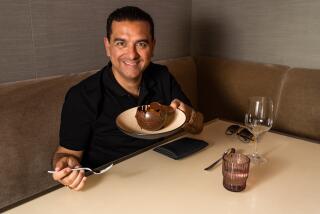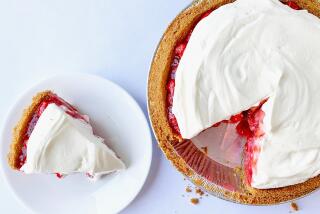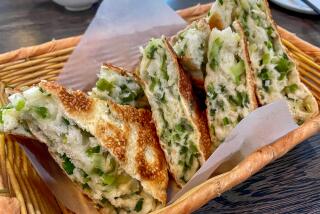Miracle crust from the master
MAURY RUBIN knows crust. If you’ve had the lemon tart at City Bakery in Brentwood, you might describe his crust as almost ethereal, so buttery and rich, crisp yet tender. If only he would show you how to make it .
Maybe his tart crust is magic because it was the beginning of something — something big — born from time spent in an Upper West Side apartment testing recipes and staring at the wall as he contemplated starting his first bakery. In 1990, Rubin opened the original City Bakery near Manhattan’s Union Square, and his tarts would become famous (he’s written a book about them, aptly titled “Book of Tarts”). In February, after months of public anticipation, he opened the second City Bakery in the Brentwood Country Mart.
FOR THE RECORD:
Cranberry, caramel and almond tart: In a recipe that ran in the Nov. 15 Food section, the total time to prepare the tart should be 1 hour, plus 3 1/2 hours chilling and cooling time. Also, to make the caramel, use a deep 10-inch skillet (it shouldn’t be nonstick). If the caramel cooks unevenly, gently tilt or swirl the pan so that the sugar is evenly distributed. Remove it from the heat before whisking in the cream and butter; if the caramel seizes, return it to the heat and continue to stir until it is smooth and creamy. The nutritional breakdown was for each of 10 servings. An updated recipe can be found at latimes.com/pies. —
Conventional wisdom would have you believe that making a great crust is difficult. A pie crust should be flaky, a tart crust crisp, and you jump through hoops trying to achieve that, because what is a pie or tart without a good crust? A disappointment. So you worry about whether your butter is cold enough. You stare into the bowl of the food processor, trying to determine whether the butter and flour you’ve just pulsed together have formed pieces the size of oatmeal flakes or the size of peas. You handle the dough gingerly, so as not to render it tough once it bakes.
But one recipe can change all that. You don’t need a food processor or even a mixer. You’re not scrutinizing your dough, hoping to see what looks like snowy peas or barley or the Infant Jesus of Prague. You don’t have to worry about overworking the dough because even if you knead it and slap it and press into it to patch up some torn spots, it turns out great.
The recipe is for Rubin’s standard tart dough, a traditional pâte sucrée with at least one notable distinction — a little cream. “It’s not so common for pâte sucrée to have cream,” Rubin says. “It gives it a little more flavor, a little more richness, a little more fat.” These are the things that bakeries are made of.
Rubin studied pastry in a tiny town called Yssingeaux in the Auvergne region of France under the tutelage of Denis Ruffel. Ruffel set him up as an apprentice at Patisserie Rousseau-Seurre in Paris’ 9th arrondissement. “It wasn’t a plan,” Rubin says of becoming a baker. “I did it, I loved it, I stayed with it.” And now he is known not only for his tarts, but for his hot chocolate and house-made marshmallows and part-bread-part-pastry pretzel croissants that have a beautiful brown crust dotted with sesame seeds and an interior that’s all layers of pillowy-soft tenderness.
But before there was hot chocolate and marshmallows and cookies and muffins, there were tarts. “From the very beginning, there were tarts — tarts and croissants, classic French viennoisserie. No cookies and muffins,” Rubin says. “My tarts are French in technique but American in personality. I’ve always liked the tart as a vehicle to do a lot of different things.”
Things like lemon tart (Rubin recently has picked up some Meyer lemons), passion fruit tart, Milky Way tart, chocolate tart, blueberry-coconut tart, “orange tart made out of apples,” tropical chocolate tart and “the world’s first stuffed raspberry tart,” in which the cavities of the raspberries are filled with chocolate.
Now, feeling a little out of place in near-80-degree weather, he’s preparing for his first Thanksgiving in Los Angeles, “ordering a lot of butter, eggs and sugar” for such holiday offerings as Indian apple pie and pumpkin pie and a show-stopping cranberry, caramel and almond tart.
As he makes his way across the big, sunny bakery in plaid shorts and blue cardigan, he’s greeted with “Hi, Maury!” from customers and employees alike. He divides his time between the store, the office and the kitchen. He still bakes pastry every day.
In the kitchen, he mixes the dough for the crust of a cranberry, caramel and almond tart — it takes less than a minute. “The tendency is for people to disbelieve that it can be that easy,” he says. “Believe it. It’s that easy.”
Step-by-step guide
RUBIN uses a standing mixer but says you can even use your hands, but not a spoon. “Once you leave the realm of bare hands, I’m a believer in the right piece of equipment.” He mixes powdered sugar with soft butter just until incorporated, drops in an egg yolk and whirs that in until the mixture is uniform, then adds the flour in two batches, and lastly the cream.The result is a “simple shaggy mass of dough.” Flinging organic flour across his pastry board (he uses organic ingredients whenever possible and is planning on opening his second “green” bakery in New York, named Birdbath), Rubin gathers up the dough, wraps it in plastic and puts it in the refrigerator.
“What’s important is that it be chilled evenly,” he says. “If it’s too soft inside, then you have a temperature issue.” Once it’s chilled, he starts flinging more flour (“all the time you want to be dusting a thin layer of flour”), cuts the dough in half and then each piece in half again; he turns it and repeats the sequence so that he ends up with 16 equal pieces, then kneads it back together into one new mass, making the dough easier to work with. “It’s like bread. You can work it and work it and work it” without compromising the resulting texture.
Then he rolls out the dough (“you can patch it if it breaks”) to about one-eighth-inch thick, trims it into a large circle and pricks holes all over it. To lift the dough, he rolls about a third of it around the rolling pin, lifts it up and lowers it into a ring. (Rubin says he prefers using a flan ring because it makes for clean lines, but you could also use a fluted tart pan.) He lightly presses the dough into the pan, forming it to the sides, trims the excess, then puts it in the freezer for an hour. “It’s a very tender dough; it wants to rest because it’s been through the equivalent of plastic surgery,” he says. “The freezer gives it a chance to relax and prevents the gluten from developing.”
Rubin blind-bakes the crust — baking it first without the filling — and says it’s better to bake it a little too long than not enough because that’s what will form a buffer for the filling, a big gooey, toasty, sweet pile of caramel, almonds and cranberries. (Rubin recommends using frozen cranberries as they keep their shape and color better than fresh ones.) The whole thing goes back in the oven and what comes out might be the best Thanksgiving tart you’ll ever make. “This tart dough will turn out when it’s made at home,” Rubin says. “It’s absolutely, easily delicious. The recipe gets you a long ways.”
People’s eyes get wide when they sink their forks into it, make their way through that sticky mess of nuts and fruit and buttery caramel and finally hit crisply luscious golden crust.
For pies, it’s even easier
EVEN easier to make is a pumpkin pie with a thick graham cracker crust that you just press into the pan, filled with a creamy pumpkin custard.The only thing you need to watch out for is baking it too long, which means it will get too firm. When it comes out of the oven it should be very, very soft. It sets up overnight in the refrigerator.
“For pumpkin pie, I’ve been around the block with all the different kinds of variations. And you know what? Maybe it’s like when a woman starts dating. She wants a studly guy, a rich guy, but then she says to herself, ‘I just want a really nice guy.’ This pumpkin pie — really nice guy.”
bettyhallock@latimes.com
*Cranberry, caramel and almond tart
FOR THE RECORD:
In this recipe that ran in the Nov. 15 Food section, the total time to prepare the tart should be 1 hour, plus 3 1/2 hours chilling and cooling time. Also, to make the caramel, use a deep 10-inch skillet (it shouldn’t be nonstick). If the caramel cooks unevenly, gently tilt or swirl the pan so that the sugar is evenly distributed. Remove it from the heat before whisking in the cream and butter; if the caramel seizes, return it to the heat and continue to stir until it is smooth and creamy. The nutritional breakdown was for each of 10 servings.
Total time: 1 hour, plus 3 1/2 hours chilling and cooling time
Servings: 10 to 12
Note: From Maury Rubin, chef-owner of City Bakery. You can use your hands to mix the dough instead of a mixer. You will need a 9-inch tart ring or fluted tart pan.
Standard tart dough
13 tablespoons (1 stick plus 5 tablespoons) unsalted butter, cut into 1-inch pieces
1/3 cup powdered sugar
1 egg yolk
1 1/2 cups unbleached flour
1 tablespoon heavy cream
1. Let the butter sit at room temperature for 15 minutes, until malleable.
2. Place the powdered sugar in the bowl of a standing mixer. Add the pieces of butter and toss to coat. Using a paddle attachment with a standing mixer, combine the sugar and butter at medium speed, until the sugar is no longer visible.
3. Add the egg yolk and combine until no longer visible.
4. Scrape down the butter off the sides of the bowl. Add half of the flour, then begin mixing again until the dough is crumbly. Add the remaining flour and then the cream and mix until the dough forms a sticky mass.
5. Flatten the dough into a thick pancake, wrap it in plastic and refrigerate at least 2 hours before preparing to roll out the dough.
6. Lightly butter a 9-inch pastry ring (or fluted tart pan) and place it on a baking sheet lined with parchment paper or a nonstick Silpat pad.
7. Once the dough has thoroughly chilled, cut it in half, then cut each piece in half lengthwise. Rotate the dough 90 degrees and repeat, until you have 16 equal pieces. Work quickly with the dough so that it remains chilled. Sprinkle your work surface with a thin layer of flour. Knead the pieces of dough together until it forms one new mass and shape it into a flattened ball. Flour a rolling pin and sprinkle flour again on the work surface underneath the dough. Roll out the dough into a circle one-eighth-inch thick.
8. To easily transfer the dough into the ring or tart pan, fold it in half gently, then in quarters. Move the folded dough to the tart ring or pan, with the point of the dough in the center, then unfold it, gently patting the dough into the bottom and up the sides of the ring. Trim the edges so that they are flush with the top of the ring. Dock the dough with a pastry docker or prick the dough all over with a fork.
9. Put the baking sheet and pastry ring into the freezer for 1 hour.
10. Heat the oven to 350 degrees. Place the baking sheet and ring in the oven and bake 20 to 25 minutes or until the dough is lightly browned. Remove from the oven and let cool to room temperature before filling.
Filling and assembly
1 1/4 cups heavy cream
1/2 cup (1 stick) unsalted butter, cut into eight pieces
1 cup granulated sugar
1 3/4 cup frozen cranberries
2 cups unblanched sliced almonds
1. Measure the cream and butter into a saucepan and heat it over low heat. When the butter has melted completely, remove from heat.
2. To make the caramel, spread the sugar evenly in a perfectly dry, deep 10-inch skillet and place it over medium-low heat.
3. The sugar should turn straw-colored, then gold and then a nutty-brown caramel after about 10 minutes. If the sugar cooks unevenly, gently tilt or swirl the pan to evenly distribute the sugar. Remove from heat and slowly whisk the cream and butter into the sugar, which can splatter as the cream is added (long sleeves are a good precaution). If the caramel seizes, return it to the heat and continue to stir until it is smooth and creamy. Strain the caramel into a bowl and cool it for 30 minutes.
4. Stir the frozen cranberries and the almonds into the caramel and mix until all the fruit and nuts are coated. Spoon the filling into the partially baked tart dough mounding toward the center.
5. Bake for 25 to 30 minutes, until the juices and the caramel are bubbling slowly around the edges. Remove from the oven and let stand for 1 hour, then gently lift the tart ring off the pastry.
6. Carefully transfer the tart to a serving platter. Serve warm or at room temperature.
Each of 10 servings: 594 calories; 7 grams protein; 43 grams carbohydrates; 3 grams fiber; 45 grams fat; 23 grams saturated fat; 126 mg. cholesterol; 16 mg. sodium.
*
Pumpkin pie
Total time: 1 hour, 10 minutes
Servings: 12
Note: From Maury Rubin. If using organic/natural graham crackers, place them in a food processor, add 2 tablespoons of sugar, then pulse until finely ground. Organic graham crackers are available at Whole Foods Markets and Trader Joe’s. You will need one (9-inch) tart pan.
1 3/4 cups (15-ounce can)
pumpkin purée
1/3 cup plus 1 tablespoon granulated sugar, divided
1/2 cup organic brown sugar
1 cup heavy cream
1 egg plus 1 egg yolk
1/3 cup honey
1 tablespoon cornstarch
1/2 teaspoon ground ginger
1/2 teaspoon cinnamon
Pinch nutmeg
Pinch cloves
Pinch salt
1cup fine graham cracker crumbs (from 8 to 9 graham crackers)
3tablespoons flour
1/2 cup melted, slightly cooled butter
1. In a large bowl, with a wooden spoon, mix together the pumpkin purée, one-third cup sugar, the brown sugar, cream, eggs, honey, cornstarch, ginger, cinnamon, nutmeg, cloves and salt. Mix until well blended. Set aside.
2. Heat the oven to 350 degrees. Place the graham cracker crumbs into a large bowl. Add the flour and the remaining 1 tablespoon sugar and, with your hand, mix to combine.
3. Add the melted butter in a stream into the middle. With your hand or a large spoon, mix all ingredients until a paste-like dough is formed.
4. Fill the tart pan by patting the dough into the bottom of the pan and around the sides. Chill 10 minutes in the refrigerator. Pour the filling into the crust. Bake about 25 minutes. The pumpkin should be firm around the edges but still soft in the center. Allow to cool, then chill overnight.
Each serving: 286 calories; 2 grams protein; 34 grams carbohydrates; 1 gram fiber; 17 grams fat; 10 grams saturated fat; 82 mg. cholesterol; 75 mg. sodium.
More to Read
Eat your way across L.A.
Get our weekly Tasting Notes newsletter for reviews, news and more.
You may occasionally receive promotional content from the Los Angeles Times.











